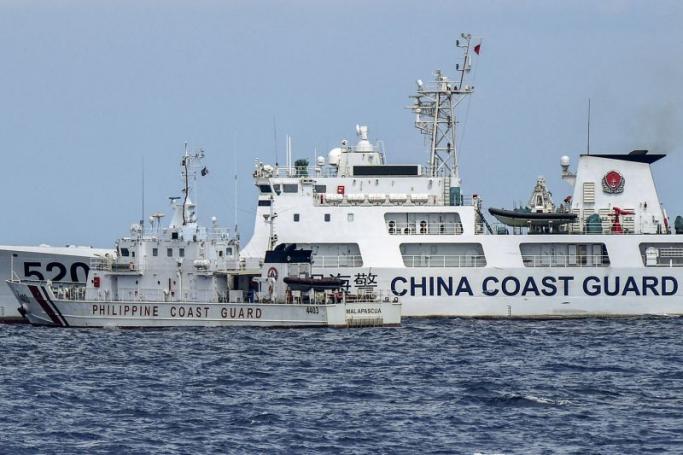AFP
As a Philippine Coast Guard rubber boat carrying journalists sped towards Filipino troops on a grounded navy vessel in the disputed South China Sea, three Chinese speed boats gave chase.
The high seas pursuit near Second Thomas Shoal in the Spratly Islands on Friday ended when Philippine Navy inflatable speed boats deployed from the crumbling BRP Sierra Madre and blocked the approaching Chinese vessels.
Moments later, the Philippine Coast Guard craft carrying AFP and a local media outlet slipped into the shallow waters of the shoal.
It floated about 180 metres (200 yards) from the World War II-era BRP Sierra Madre where a handful of marines are stationed -- one of nine Philippine outposts in the hotly contested Spratlys.
The rusty hulk has been a flashpoint for Manila and Beijing since the Philippine Navy ran it aground in 1999 to check China's advance in the waters.
China claims almost the entire South China Sea and has ignored an international ruling that its stance has no legal basis.
It deploys steel-hulled ships and speed boats to patrol the waters and reefs in the sea, and has built artificial islands that it has militarised to reinforce its claims.
Tensions have escalated under Philippine President Ferdinand Marcos, whose administration has been increasingly vocal in criticising Chinese actions in the sea.
Resupply and rotation missions to the BRP Sierra Madre have become a frequent trigger of diplomatic spats between the countries.
Manila accuses Chinese vessels of harassing and blocking Philippine boats delivering food, water and materials for badly needed repairs.
Beijing, which has urged Manila to remove the ship, insists the Philippine vessels are infringing China's territorial sovereignty.
Second Thomas Shoal is about 200 kilometres (120 miles) from the western Philippine island of Palawan, and more than 1,000 kilometres from China's nearest major landmass, Hainan island.
On Friday, the Philippines accused the Chinese coast guard of "dangerous harassment" of Filipino boats near the reef, including firing a water cannon and blocking vessels.
The incident happened nearly three weeks after two collisions between Chinese and Philippine vessels during another resupply mission, with the countries trading blame.
- 'Shoulder-to-shoulder' –
China's actions have sparked international concern and fueled fears for a potential accident or miscalculation serious enough to ignite a military conflict.
Manila's longtime ally Washington reiterated Friday that its mutual defence pact with the Philippines "extends to armed attacks on Philippine armed forces, public vessels, or aircraft -– including those of its Coast Guard -– anywhere in the South China Sea."
"The United States stands shoulder-to-shoulder with our Philippine ally in the face of the People's Republic of China's (PRC) repeated harassment in the South China Sea," US State Department spokesman Matthew Miller said in a statement.
As the journalists sat in the rubber boat under a cloudy sky observing the dilapidated state of the BRP Sierra Madre on Friday, a US maritime patrol plane circled overhead.
The Philippine Coast Guard identified five Chinese coast guard, 28 "maritime militia" and five navy vessels floating nearby.
The Philippines was vastly outnumbered, with three coast guard vessels escorting two small wooden supply boats chartered by the Armed Forces of the Philippines to deliver provisions to the troops.
The Philippine coast guard and navy also deployed three rigid-hulled inflatable boats each to assist in the mission, which was completed Friday.
AFP












